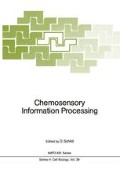Abstract
Major advances in neuroscience have often followed directly from the application of new and more powerful methodological approaches to the study of brain structure and function (Clarke & Jacyna, 1987). Within the last decade a new technique has been developed that allows both brain structure and function to be studied in a closely integrated and highly complimentary fashion. This technique is multiple-site optical recording of membrane potential, or more simply, optical recording. Optical recording is based upon the ability of certain vital dyes (potentiometric probes) to optically signal changes in intracellular membrane potential. By viewing brain tissue stained with a voltage-sensitive dye with a suitable light detector system, changes in neuronal activity can be monitored simultaneously from a 100 or more contiguous anatomical regions (cf. Grinvald et al., 1988).
Access this chapter
Tax calculation will be finalised at checkout
Purchases are for personal use only
Preview
Unable to display preview. Download preview PDF.
References
Adrian ED (1950) Sensory discrimination with some recent evidence from the olfactory organ. Br Med Bull 6:330–333
Adrian ED (1951) Olfactory discrimination. Annee Psychol 50:107–113
Clarke E, Jacyna, LS (1987) Nineteenth-century origins of neuroscientific concepts. Univ of Calif Press, Berkekey, CA
Cohen LB, Lesher S (1986) Optical monitoring of membrane potential. In: DeWeer P, Salzberg BM (eds) Optical methods in cell physiology. New York, pp 71–99
Gesteland RC (1971) Neural coding in olfactory receptor cells. In: Beidler LM (ed) Handbook of sensory physiology, olfaction. Springer, New York, pp 132–150
Getchell TV (1974) Unitary responses in the frog olfactory epithelium to sterically related molecules at low concentrations. J Gen Physiol 64:241–261
Getchell TV, Shepherd GM (1978) Responses of olfactory receptor cells to step pulses of odour at different concentrations in the salamander. J Physiol (Lond) 282:521–540
Grinvald A, Frostig RD, Lieke E, Hildesheim R (1988) Optical imaging of of neuronal activity. Physiol Rev 68:1285–1366
Herrick CJ (1948) The brain of the tiger salamander. Univ of Chicago Press, Chicago, IL
Holley A, Duchamp A, Revial MF, Juge A, MacLeod P (1974) Qualitative and quantitative discrimination in the frog olfactory receptors: analysis of electrophysiological data. Ann NY Acad Sci 237:102–114
Kauer JS, Senseman DM, Cohen LB (1987) Odor-elicited activity monitored simultaneously from 124 regions of the salamander olfactory bulb using a voltage-sensitive dye. Brain Res 418:255–261
Kauer JS (1988) Real-time imaging of evoked activity in local circuits of the salamander olfactory bulb. Nature (Lond) 331:166–168
Liljeborg A (1988) Digital position encoding of galvanometer scanner in a laser microscope. Optical Eng 27:818–822
Moulton DG (1967) Spatio-temporal patterning of response in the olfactory system. In: Hayashi T (ed) Olfaction and Taste II, Pergamon, Oxford pp 109–116
Moulton DG (1976) Spatial patterning of responses to odors in the peripheral olfactory system. Physiol Rev 56:578–593
Moulton DG, Tucker D (1964) Electrophysiology of the olfactory system. Ann NY Acad Sci 116:380–428
Moulton DG, Beidler LM (1967) Structure and function in the peripheral olfactory system. Physiol Rev 47:1–52
Nash PL, Muljadi P, Wayner MJ, Senseman DM (1988) High-speed imaging of olfactory of electrical activity: watching the brain think on MTV/2. Neural Networks 1:268
O’Connell RJ, Mozell MM (1969) Quantitative stimulation of frog olfactory receptors. J Neurophysiol 32:51–63
Orbach HS, Cohen LB (1983) Optical monitoring of activity from many areas of the in vivo and in vitro salamander olfactory bulb: a new method for studying functional organization in the vertebrate central nervous system. J. Neurosci 3:2251–2262
Salzberg BM, Obaid AL, Senseman DM, Gainer H (1983) Optical recording of action potentials from vertebrate nerve terminals using potentiometric probes provides evidence for sodium and calcium components. Nature (Lond) 306:36–40
Senseman, DM, Horwitz IS, Salzberg BM (1987) MSORTV imaging of electronic conduction in an electrical syncitium: optical recording of polarization spread in a simple salivary gland. J Exp Zool 244:79–89
Author information
Authors and Affiliations
Editor information
Editors and Affiliations
Rights and permissions
Copyright information
© 1990 Springer-Verlag Berlin Heidelberg
About this paper
Cite this paper
Senseman, D.M., Vasquez, S., Nash, P.L. (1990). Animated Pseudocolor Activity Maps (Pam’s): Scientific Visualization of Brain Electrical Activity. In: Schild, D. (eds) Chemosensory Information Processing. NATO ASI Series, vol 39. Springer, Berlin, Heidelberg. https://doi.org/10.1007/978-3-642-75127-1_23
Download citation
DOI: https://doi.org/10.1007/978-3-642-75127-1_23
Publisher Name: Springer, Berlin, Heidelberg
Print ISBN: 978-3-642-75129-5
Online ISBN: 978-3-642-75127-1
eBook Packages: Springer Book Archive

